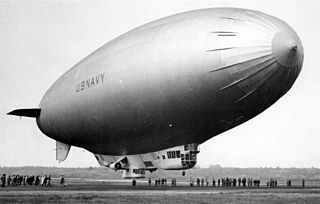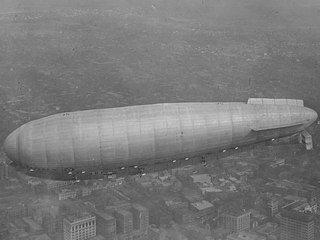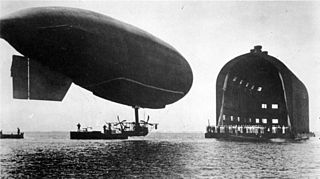
A blimp (/blɪmp/), or non-rigid airship, is an airship (dirigible) without an internal structural framework or a keel. Unlike semi-rigid and rigid airships, blimps rely on the pressure of the lifting gas inside the envelope and the strength of the envelope itself to maintain their shape. Blimps are known for their use in advertising, surveillance, and as observation platforms due to their maneuverability and steady flight capabilities.

An airship or dirigible balloon is a type of aerostat or lighter-than-air aircraft that can navigate through the air under its own power. Aerostats gain their lift from a lifting gas that is less dense than the surrounding air.

The Norge was a semi-rigid Italian-built airship that carried out the first verified trip of any kind to the North Pole, an overflight on 12 May 1926. It was also the first aircraft to fly over the polar ice cap between Europe and America. The expedition was the brainchild of polar explorer and expedition leader Roald Amundsen, the airship's designer and pilot Umberto Nobile and the wealthy American adventurer and explorer Lincoln Ellsworth who, along with the Aero Club of Norway, financed the trip, which was known as the Amundsen-Ellsworth 1926 Transpolar Flight.

The K-class blimp was a class of blimps built by the Goodyear Aircraft Company of Akron, Ohio for the United States Navy. These blimps were powered by two Pratt & Whitney Wasp nine-cylinder radial air-cooled engines, each mounted on twin-strut outriggers, one per side of the control car that hung under the envelope. Before and during World War II, 134 K-class blimps were built and configured for patrol and anti-submarine warfare operations, and were extensively used in the Navy’s anti-submarine efforts in the Atlantic and Pacific Ocean areas.

The G-Class Blimps were a series of non-rigid airships (blimps) used by the United States Navy. In 1935, instead of developing a new design airship, the Navy purchased the Goodyear Blimp Defender for use as a trainer and utility airship assigning it the designator G-1. Defender was built by the Goodyear Aircraft Company of Akron, Ohio and was the largest blimp in the company’s fleet of airships that were used for advertising and as passenger airships. Goodyear built additional G-class airships for the Navy during World War II to support training needs.

The J-class blimps were non-rigid airships designed by the Navy Bureau of Aeronautics and Goodyear Tire & Rubber Company in the early 1920s for the US Navy.

The Goodyear Aircraft Company of Akron, Ohio built the M-class blimp for the US Navy as the follow-on to the K-class anti-submarine warfare blimp used during World War II. It was a significantly larger airship, 50% larger than its predecessor. Four airships, designated M-1 through M-4, were delivered in early 1944. Operations of K-ships in tropical regions had shown a need for a blimp with greater volume to offset the loss of lift due to high ambient temperatures.

The N-Class, or as popularly known, the "Nan ship", was a line of non-rigid airships built by the Goodyear Aircraft Company of Akron, Ohio for the US Navy. This line of airships was developed through many versions and assigned various designators as the airship designation system changed in the post World War II era. These versions included airships configured for both anti-submarine warfare and airborne early warning (AEW) missions.

Roma was an Italian-built semi-rigid airship, designated by its designer as the Model T-34. Purchased by the United States from the Italian government in 1921, Roma was operated by the United States Army Air Service from November 1921 to February 21, 1922, when it crashed in Norfolk, Virginia, killing 34 people aboard, with 9 survivors. As a result of this accident, Roma was the last hydrogen inflated airship flown by the US military; all subsequent airships were inflated with helium.

The DN-1 was the United States Navy's first airship.

The B class blimps were patrol airships operated by the United States Navy during and shortly after World War I. The Navy had learned a great deal from the DN-1 fiasco. The result was the very successful B-type airships. Dr. Jerome Hunsaker was asked to develop a theory of airship design, Lt. John H. Towers had returned from Europe having inspected British designs, and using reports from attachés on British airship operations, the Navy was prepared to seek bids for blimps from American manufacturers. On 4 February 1917 the Secretary of the Navy directed that 16 nonrigid airships of Class B be procured. A February 12, 1917 meeting with the Chief of the Bureau of Construction and Repair, and representatives of Goodyear, Goodrich, Connecticut Aircraft Company, Curtiss Aeroplane and Motor Corporation, and U.S. Rubber Company, it was agreed that the order for 16 dirigibles was beyond the capability of any one company. The conference resulted in a committee to coordinate on sharing raw materials, information and experience. Ultimately Goodyear manufactured 9 envelopes, Goodrich made 5 and Curtiss assembled the gondolas for all of those 14 ships. Connecticut Aircraft contracted with U.S. Rubber for its two envelopes and with Pigeon Fraser for its gondolas. The Curtiss-built gondolas used by Goodyear and Goodrich used modified Curtiss JN-4 fuselages powered by Curtiss OXX engines. The Connecticut Aircraft blimps were powered by Hall-Scott engines. One ship, B-20 was equipped with a special control car. All B-Class airships were delivered to the Navy between August 1917 (B-1) and September 1918 (B-20).

The D class blimp was a patrol airship used by the US Navy in the early 1920s. The D-type blimps were slightly larger than the C-type and had many detail improvements. The Navy continued the practice of dividing the envelope production between Goodyear and Goodrich. The control cars were manufactured by the Naval Aircraft Factory. The major improvements over the C-type blimps were a better control car design and easier, more reliable controls and instrumentation. The engines were moved to the rear to reduce noise and allow easier communications between crew members. The fuel tanks were suspended from the sides of the envelope. The envelope was identical to the C-type, except an additional six-foot panel was inserted for a total length of 198 feet (60 m) and a volume of 190,000 cubic feet (5,400 m3). The last of the D-Class, D-6, had a redesigned control car by Leroy Grumman who later founded the Grumman Aircraft Engineering Corporation.

The F class of US Navy blimps comprised a single airship, built during World War I by Goodyear as one of a group of three small blimps offered to the US government. Two were purchased for the US Navy and one for the US Army. The Navy blimps were designated E-1, F-1, and the Army airship A-1. Classified as an "Experimental Engine Testing Dirigible." F-1 had the same envelope size as the E-1, due to the use of a tractor mounted 125 hp Union engine, the performance was different. F-1 spent its entire career at Hampton Roads. It was flown in both tractor and pusher configurations. It also may have been flown with a Curtiss OXX engine. F-1 was removed from inventory in November 1923.
The K-1 was an experimental blimp designed by the United States Navy in 1929. The K-1 was not the prototype of the later K-class blimps.

A semi-rigid airship is an airship which has a stiff keel or truss supporting the main envelope along its length. The keel may be partially flexible or articulated and may be located inside or outside the main envelope. The outer shape of the airship is maintained by gas pressure, as with the non-rigid "blimp". Semi-rigid dirigibles were built in significant quantity from the late 19th century but in the late 1930s they fell out of favour along with rigid airships. No more were constructed until the semi-rigid design was revived by the Zeppelin NT in 1997.
The Goodyear Type AD was a small airship built in the United States in the mid-1920s. The first example, christened Pilgrim, was Goodyear's first civil airship, and their first airship to use helium as its lift gas. Originally intended for pleasure cruising, it soon found its true calling as a promotional vehicle as the first "Goodyear Blimp" in a line that has continued for over ninety years. The Type AD was a conventional blimp design with a gondola that could carry two passengers in addition to the flight crew. While usually described as a non-rigid type, the design in fact incorporated a triangular-section magnesium girder as a keel, fastened inside the envelope. The craft carried its own collapsible mooring mast which allowed it to "land" anywhere that 250 ft × 250 ft of clear ground was available.

The Goodyear GZ-20/20A was a class of non-rigid airship or blimp introduced in 1969 by The Goodyear Tire and Rubber Company in the United States as its signature promotional aircraft, the Goodyear Blimp. The design is based on the previous Goodyear GZ-19 class. The GZ-20 featured a larger envelope to carry the "Super-Skytacular" advertising night sign and more powerful engines. The GZ-20s were the mainstay of Goodyear's airship operations until 2017, when they were replaced with the new Zeppelin NT semi-rigid airship.

The Willows airships were a series of pioneering non-rigid airships designed and built in Wales by Ernest Thompson Willows in the first decade of the 20th century. The first airship Willows No. 1 flew in 1905, and the last, the Willows No. 5 in 1913.

SSclass airships were simple, cheap and easily assembled small non-rigid airships or "blimps" that were developed as a matter of some urgency to counter the German U-boat threat to British shipping during World War I. A secondary purpose was to detect and destroy mines. The class proved to be versatile and effective, with a total of 158 being built in several versions.
















